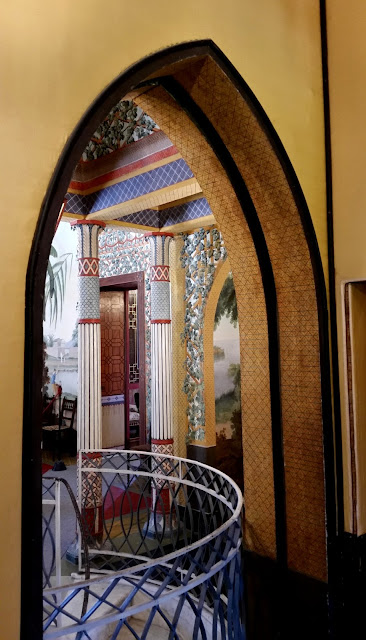A traveler could spend months wandering the streets of Palermo and still not get to see every attraction that this fascinating city has on offer. There are countless historical churches, museums, galleries and palaces to explore. And even having the good fortune of staying here for three weeks, I have had to do my research and be very selective in how I spend my time and on what cobblestones I wear my sandals ( and knees ... ) out ... so having delved into the www history sites ( how ever did we manage before the Internet ... ), I put together a list of sites and sights to visit ... and so today's excursion takes me into the outer NW suburbs to wander through one such palace that is very much top of the list ...
firstly it's a tram ride ...
then two bus rides ...
then a long walk in the hot Sicilian sun ...
to the gates of the very exotic 18th century Chinese Palace ...
Palazzina Cinese ( The
Chinese Palace ), is a former royal residence
of the House of Bourbon-Two Sicilies
designed in the 18th century style of Chinoiserie.
of the House of Bourbon-Two Sicilies
designed in the 18th century style of Chinoiserie.
This extraordinary example of architecture-gone-crazy was designed in 1799 by the architect Giuseppe Venanzio Marvuglia on
commission by the King Ferdinand III of Sicily. The ruler had previously bought
the land and a smaller house that was Chinese in design, belonging to the Baron Benedetto
Lombardo. The architectural complex and its
extensive manicured gardens were completed between 1800 and 1806.
The Palace is not large on the grand European-palace scale, and the few apartments are distributed on three floors. On the first floor
there are the reception hall, a dining room and the bedroom of the King. On the
second floor there is the apartment of the Queen Maria Carolina of Austria. On
the third floor there's an octagonal terrace covered like a pagoda ... don't know where the kids, servants or guests hung out ... !!! ....
In
1860, as a result of the Unification of Italy, the residence passed to the
House of Savoy until the Constitutional Referendum of 1946 ( when the Italian
Republic was proclaimed and the monarchy abolished ). Then, it became the
property of various private owners until the late 1900s when the Comune of Palermo
took possession, and after much restoration the building was converted into the current day museum.
The
interior of the building is richly decorated with paintings and frescoes in a
Neoclassical style, chiefly by Sicilian artists Giuseppe Velazquez ( 1750 to1827
) and Vincenzo Riolo ( 1772 to 1837 ).
To avoid being yelled at in cross Italiano by the officious and ever present guards, one must remain on the carpet and definitely not stray onto the marbled floors ...
Ferdinand III - King of the Two Sicilies.
Now
if you think the governments of post World War II Italy are complicated – just let me take you
back to Ferdinand’s times in the 18th Century …
Ferdinand
( 1751 to 1825 ) was the third son of King Charles III of Spain, Naples and
Sicily - by his wife, Maria Amalia of Saxony. On 10 August 1759, Charles
succeeded his elder brother, Ferdinand VI, but treaty provisions made Charles
ineligible to hold all three crowns. On 6 October, he abdicated his Neapolitan
and Sicilian titles in favour of his third son, because his eldest son, Philip
had been excluded from succession and his second son, Charles, was heir to the
Spanish throne.
Ferdinand
was styled both Ferdinand III of Sicily ( 6 October 1759 – 12 December 1816 )
and Ferdinand IV of Naples ( 6 October 1759 – 23 January 1799 when he was deposed
by the revolutionary Parthenopean Republic for six months – then reinstated on the throne 13 June
1799 – 30 March 1805 when he was deposed by Napoleon Bonaparte Napoleon I who replaced
him with his own brother Joseph Bonaparte – and finally ( following the defeat
of Napoleon’s army by the Austrians at the Battle of Tolentino ( 3 March 1815 )),
Ferdinand regained the throne on 22 May 1815 until 12 December 1816 when he merged
the thrones of Sicily and Naples into the throne of the Two Sicilies and became
the King of the Two Sicilies.
He
continued to rule until his death on 4 January 1825 ... hope you were able to follow that brief history lesson ... now back to the Palace - and a quick wander around the outside and through the garden - before I expire from heat exhaustion and need to head back to the bus and home to the 21st century luxury of air conditioning ...
view of the garden from the rear terrace ...
wonderful design on the colonnade
and finally the view of the rear of the Palace from the garden ...
... more Sicilian palaces to come ...









































No comments:
Post a Comment
Note: Only a member of this blog may post a comment.